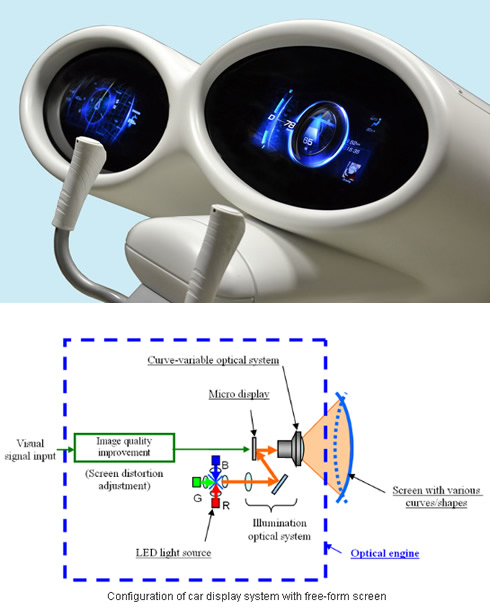
Mitsubishi Car Display System Projects Images on Curved Screens
Mitsubishi Electric has developed a prototype car display system with an optical engine that can project images on curved, oval or triangular screens to suit a wide range of car interiors.
The system's free-form screen responds flexibly to the increasing use of curves and other design features in car interiors. At the same time, its visibility helps to promote driving safety.
Mitsubishi's original curve-variable optical system projects images on screens of various shapes to minimize blur in screen areas with deep curves. The prototype system's single optical engine adapts to a wide range of surfaces, unlike conventional displays that require a designated optical engine designed for a screen's specific curves or shape.
The company says that distortion-free images are projected on curved, oval or triangular surfaces through a screen distortion adjustment process that predicts the distortion of images caused by complex curves, and adjusts visual signal input.

To ensure steady performance, Mitsubishi also developed a hybrid cooler that combines systems for highly efficient radiation and natural and forced-air cooling. In addition, the overall structure minimizes distortion of the optical engine and chassis due to vibration or shock while driving. The display also incorporates a plastic screen that absorbs light to maintain great visibility in bright environments.
The display system incorporates red, green and blue LEDs for its light source to achieve a color gamut 1.5-times wider than conventional displays that use white LED backlights. In addition, a light sensor separately controls light emissions from the different LEDs, each having its own temperature characteristics, and maintains color balance to stabilize color reproduction in a wide range of temperatures.
Mitsubishi Electric did not announce when it planned to commercialize the new system.
Mitsubishi's original curve-variable optical system projects images on screens of various shapes to minimize blur in screen areas with deep curves. The prototype system's single optical engine adapts to a wide range of surfaces, unlike conventional displays that require a designated optical engine designed for a screen's specific curves or shape.
The company says that distortion-free images are projected on curved, oval or triangular surfaces through a screen distortion adjustment process that predicts the distortion of images caused by complex curves, and adjusts visual signal input.

To ensure steady performance, Mitsubishi also developed a hybrid cooler that combines systems for highly efficient radiation and natural and forced-air cooling. In addition, the overall structure minimizes distortion of the optical engine and chassis due to vibration or shock while driving. The display also incorporates a plastic screen that absorbs light to maintain great visibility in bright environments.
The display system incorporates red, green and blue LEDs for its light source to achieve a color gamut 1.5-times wider than conventional displays that use white LED backlights. In addition, a light sensor separately controls light emissions from the different LEDs, each having its own temperature characteristics, and maintains color balance to stabilize color reproduction in a wide range of temperatures.
Mitsubishi Electric did not announce when it planned to commercialize the new system.

















